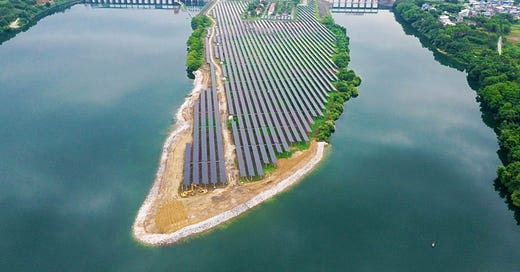Energy Insider: China Updates Standards for Electricity Market Watchdogs, Construction Begins at Sichuan’s Mega Solar Farm
China could relaunch voluntary carbon market this year, key raw materials industries get growth targets
A solar power plant in Liuzhou, Guangxi on Aug.16. Photo: VCG
In this week’s Caixin energy wrap, we analyze China’s biggest climate and energy news on policy, industry, projects and more:
• New rules for electricity market watchdogs
• Hydropower hub steps up solar power game
• Voluntary carbon market expected to restart this year
• Growth targets set for raw materials industries
• First batch of ‘cutting-edge materials’ announced
In focus: New national standards for electricity market watchdogs
What’s new: China’s top energy regulator, the National Energy Administration (NEA), has updated the operating standards for provincial electricity market management committees, in yet another step toward China’s electricity market reform.
In guiding opinions released on Aug. 25, the NEA gave a list of responsibilities of such committees, which supervise electricity trading and are independent of provincial power exchange centers. It also explained how the committees should be formed and structured and how agendas should be discussed and approved.
This is the “first national-level guidance to standardize the operation” of electricity market management committees since the central government established the market watchdogs in 2015, the NEA said in an online Q&A on Aug. 28.
The spokesperson noted that although 33 of such committees had been set up around the country, they had progressed at their own varying pace, operation, and involvement in the market.
Why it matters: The guidelines came after a boom in the trading volume of China’s national electricity market in the first six months of this year.
The establishment of provincial electricity market management committees was a small yet critical step of China’s long journey to create for its power sector a market-oriented trading mechanism — functions that had not existed in the country’s state-run power sector prior.
The latest instructions, which updated some of the rules in a 2020 electricity trading directive, showed the central government’s determination to cement the role of these watchdogs to ensure the impartiality and smooth development of its fledgling provincial power markets.
They also lay a foundation for China’s national power market, which is scheduled to be set up by 2030, according to a document issued by the National Development and Reform Commission, China’s top economic planner, and the NEA in January 2022.
Keep reading with a 7-day free trial
Subscribe to Caixin Global China Watch to keep reading this post and get 7 days of free access to the full post archives.




